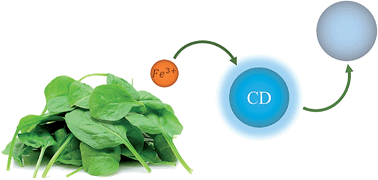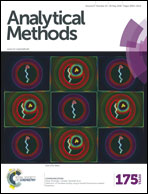Quick speciation of iron(ii) and iron(iii) in natural samples using a selective fluorescent carbon dot-based probe†
Abstract
A new, simple and rapid carbon dot (CD) based fluorescent probe for speciation of Fe2+ and Fe3+ ions was developed. The as-prepared CDs contain phenol groups on their surfaces and due to the special coordination interaction of phenol groups with Fe3+ ions, this sensing system exhibits excellent sensitivity and selectivity toward Fe3+. In order to detect Fe2+ ions as well, a specific amount of H2O2 was introduced to the detection system to transform Fe2+ to Fe3+ of which the latter is the determinable form of iron. Under the optimum experimental conditions, the fluorescence intensity of the sensor decreased as the Fe3+ ion concentration increased. The relationship plot between the fluorescence quenching and Fe3+ ion concentration was linear within the range of 1 to 100 μM and 100 to 500 μM with a detection limit of 0.17 μM. The practical use of the designed nanoprobe in spinach and water samples is also demonstrated successfully.


 Please wait while we load your content...
Please wait while we load your content...